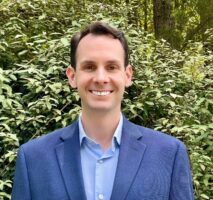The Engagement Matters Podcast
Season 1, Episode 2
Laura Sharp, PhD, the Equity Data Manager with the City of Tucson, Arizona shares her approach to capturing residents’ perspectives and unique needs, which are being incorporated into the city’s project decision-making process.
Listen now
Click on the audio player below to listen to this episode.
(Listen on any of these platforms:
Apple Podcasts, Spotify, Amazon Music, iHeartRadio, PlayerFM, Podbean)
Background
The City of Tucson, Arizona is one of the most diverse cities in the southwest. Its proximity to Native American reservations, the US-Mexico border, and a litany of natural areas all contribute to the city’s uniqueness. Yet, for all its obvious benefits, the human diversity of Tucson presents a continuing challenge to city officials: How to engage with residents to ensure that city projects benefit everyone equitably. Over the years, the city has done this by posting project information to its website and social media channels and holding public meetings. It built open data portals with ArcGIS Hub, interactive StoryMaps and dashboards, and location-aware surveys in ArcGIS Survey123 to help increase transparency and hear from residents directly. The city even started a Community Ambassador program where residents from within specific communities solicit feedback door-to-door from fellow residents in their native language and with specific project materials tailored to that community. The city has seen a solid return on all these investments, but staff and leadership knew that more could and should be done.
Start with data
In 2022, Mayor Romero and the City Council established the Office of Equity with the mission to incorporate equity into the city’s operations. The goal was to make sure “that all policies and practices positively impact everyone in the city, not just the privileged few,” according to Laura Sharp, the data manager of the Office of Equity. Laura knew that this meant two things: more data and focused engagement.
The city has a strong history of using data to support public engagement and drive policy decisions. For instance, mapped data collected from the public on the locations of homeless encampments has been used to locate where housing services and homeless outreach are most needed, while tree canopy, heat severity, and demographic data have helped identify areas where new trees should be planted. During public engagement on new projects, city staff frequently use maps to share plans with and collect input from interested residents at community meetings and through online resources. Over her six years of experience in using GIS at the city to support projects like these in different departments and teams, Laura had developed a firm understanding of the kinds of data departments had access to and what kinds of data were missing but important for advancing equity. A strategy needed to be developed to help guide data collection, use, and updates alongside engagement methods that reached all residents, not just the handful that traditionally responded to the city.
Build a strategy
Laura’s team, in conjunction with the city’s Demographic Collection Group, developed the Tucson Equity Data Strategy (TEDS). TEDS focuses the city’s efforts in five key areas:
- Collection Standards: Establishing standards for the types of questions residents are asked including the use of inclusive language and community-approved terms for describing different groups of residents.
- Equity Priority Index: Defining different ways that many datasets are combined into a single metric that helps identify which communities face specific challenges (including poverty, disability, and more).
- Equity Data Hub: The creation of an open data hub that makes it easy to find and use data that has been pre-processed to the city’s specific geographic boundaries.
- Census Tool: A web-based mapping application that summarizes and reports demographic information from the Equity Data Hub while requiring very little technical skills.
- Data Toolkit: A suite of tools for staff and others that provides templates and guidance for using demographic data.
Essentially, Laura’s team uses TEDS to provide “the tools to help departments learn about communities, which will help them engage with these communities better” without departments needing to become equity experts on their own. Traffic engineers, for example, can still focus on the engineering science of providing best in class services to the city but also have tools that help clarify when they might need to include translation services, door to door campaigns, or some other type of service when engaging with communities. When a community needs a more focused or specialized type of engagement, a department can rely on TEDS for up-to-date spatial data, ArcGIS Survey123 templates that use inclusive language and guidance on when to translate presentation materials into languages other than English. TEDS even provides guidance on when printed materials might be necessary or when Community Ambassadors might be needed if an area has a higher concentration of elderly residents that are unlikely to use online resources.
Make data actionable
This guidance comes mainly from the Equity Priority Index (EPI) which Laura’s team has developed. The goal of the Index is simple, but the science is complex. Departments take their own internal data that defines the severity of a problem they are trying to solve along with the costs of a proposed project and put these metrics into the Equity Priority Index to get a single number. This number gives different communities a score which predicts the estimated impact of the proposed project. When talking about this process with non-experts, Laura describes the Index as a tool that helps quantify where the city should invest resources for the biggest, most equitable return on investment. A hypothetical scenario she often uses involves the challenge of determining when to repave a road or just repair potholes:
“Imagine two roads with a lot of potholes… so many potholes that the roads need to be repaved. One road is in an affluent community, one is in a poorer community. The city can only repave one road this year and do minor repairs on the other. Which one should be repaved vs. repaired? The Equity Priority Index takes the project metrics – cost, timeline, etc. – and combines it with community factors to determine the impact the repaving project will have on either community. It considers that if you’re poor, have one car shared among your household and get a flat tire from a pothole, that incident can derail your budget and negatively impact your ability to get to work. On the other hand, if you’re affluent and everyone in your household has their own vehicle, getting a flat tire is more or less an inconvenience that you can handle in a few hours.”
Engagement is continual
The Equity Priority Index doesn’t make the policy decisions for the city or for the department and it doesn’t pick “winners and losers.” Instead, it tries to balance the needs of different communities, the challenges each community faces, and help guide fairer and more just decisions from the city. The result regardless of which of the two roads is repaved is that all projects in Tucson have a transparent decision history that is rooted in data. These decisions can be easily understood and communicated to residents and the Index helps track the progress that targeted interventions make toward helping uplift the most at-risk communities and improve the city’s overall health.
Adopting an equity-first mindset also helps motivate residents to take part in civic engagement. Using inclusive language, simplifying complex terminology, delivering materials in a variety of formats and in a variety of places all increases the likelihood that residents will respond to the city and stay engaged over the long run. Laura’s approach is to have “resources online, at public places like libraries, post offices, and grocery stores, and in the hands of the Community Ambassadors.” It’s an all-of-the-above approach that city staff appreciate even if it means more effort to get projects underway. All city departments have people that regularly engage with residents as part of their responsibilities: at service counters, during public meetings, responding to questions or service requests online, and more. So far, the response from staff has been overwhelmingly positive as departments view these new resources as valuable additions to their engagement toolboxes. The data that Laura provides is relevant and auto-updates so that each department doesn’t have to recreate their own version. Updated data also ensures that the Equity Priority Index is reliable and uses relevant data. These efficiencies help free up more time for staff to build flyers, tailor messaging, and ensure that the intended audience is reached within specific communities.
Scale up
The Equity Data Strategy and Equity Priority Index will continue to be updated over time as communities change and as the need in the city evolves. Both the strategy and the index that the Office of Equity have developed involved learning from other strategies and indices that similar cities developed. To other cities that are interested in doing similar work, Laura suggests starting by “creating a culture around valuing feedback and a need to hear from everyone because we can’t assume to know what’s best for people.” This culture shift begins by helping others to see that equity-based thinking and engagement aren’t just the smart thing to do, they’re moral imperatives. Developing a pilot for others to see and experience helps convince people in your organization that these kinds of challenges aren’t insurmountable. Often in issues of equity, different groups are unaware of the challenges that others may face. We have different lived experiences after all. The pilot project can help raise the visibility for the need for equity-centric engagement which will convince more people to get involved. These small successes will help galvanize support for more engagement across your organization and will help you scale up your work.
Learn More or Get Involved
If you want to know more about the Tucson Equity Data Strategy, you can read about it in the city’s interactive story here or watch a video which describes the effort here.
You can also visit the City of Tucson’s Office of Equity Website here to learn more about the Office, the team, and their current initiatives.



Article Discussion: